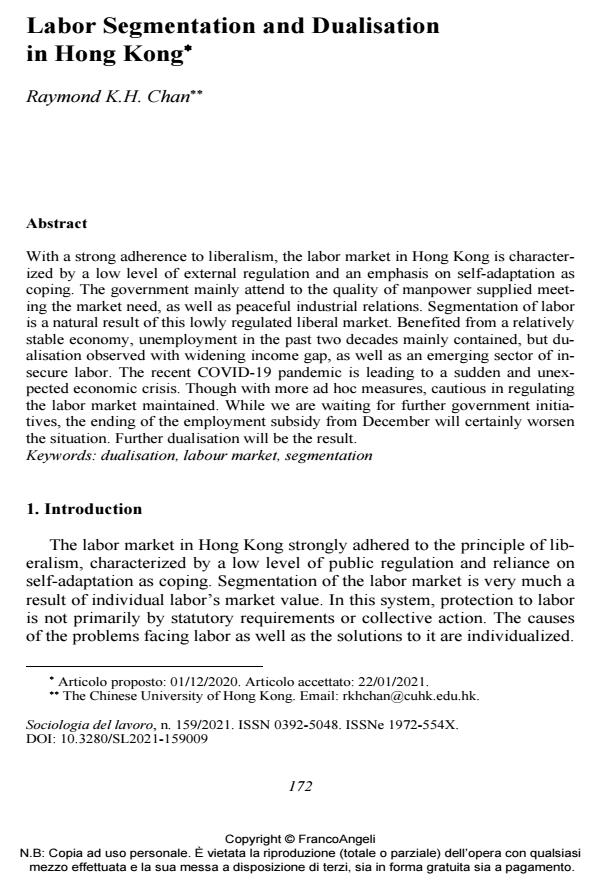Labor Segmentation and Dualisation in Hong Kong
Titolo Rivista SOCIOLOGIA DEL LAVORO
Autori/Curatori Raymond K.H. Chan
Anno di pubblicazione 2021 Fascicolo 2021/159
Lingua Inglese Numero pagine 23 P. 172-194 Dimensione file 287 KB
DOI 10.3280/SL2021-159009
Il DOI è il codice a barre della proprietà intellettuale: per saperne di più
clicca qui
Qui sotto puoi vedere in anteprima la prima pagina di questo articolo.
Se questo articolo ti interessa, lo puoi acquistare (e scaricare in formato pdf) seguendo le facili indicazioni per acquistare il download credit. Acquista Download Credits per scaricare questo Articolo in formato PDF

FrancoAngeli è membro della Publishers International Linking Association, Inc (PILA)associazione indipendente e non profit per facilitare (attraverso i servizi tecnologici implementati da CrossRef.org) l’accesso degli studiosi ai contenuti digitali nelle pubblicazioni professionali e scientifiche
With a strong adherence to liberalism, the labor market in Hong Kong is character-ized by a low level of external regulation and an emphasis on self-adaptation as coping. The government mainly attend to the quality of manpower supplied meet-ing the market need, as well as peaceful industrial relations. Segmentation of labor is a natural result of this lowly regulated liberal market. Benefited from a relatively stable economy, unemployment in the past two decades mainly contained, but dualisation observed with widening income gap, as well as an emerging sector of insecure labor. The recent COVID-19 pandemic is leading to a sudden and unex-pected economic crisis. Though with more ad hoc measures, cautious in regulating the labor market maintained. While we are waiting for further government initia-tives, the ending of the employment subsidy from December will certainly worsen the situation. Further dualisation will be the result.
Con una forte adesione al liberismo, il mercato del lavoro di Hong Kong è caratterizzato da un basso livello di regolamentazione e da un’enfasi sulla capacità di adattamento. Il governo si occupa principalmente della qualità della manodopera fornita per soddisfare le esigenze del mercato, nonché di garantire relazioni industriali pacifiche. La segmentazione del lavoro è un risultato naturale di un mercato poco regolamentato. Beneficiato da un’economia relativamente stabile, la disoccupazione negli ultimi due decenni è stata per lo più contenuta, ma è stata altresì osservata una crescente dualizzazione caratterizzata con un divario dei redditi, nonché dall’aumento del lavoro precario. La recente pandemia di COVID-19 sta causando una crisi economica improvvisa e inaspettata. Anche se con misure ad hoc, è stata comunque perpetuata la tradizionale ridotta regolamentazione del mercato del lavoro. In attesa di ulteriori iniziative del governo, la fine degli incentivi all’occupazione a partire da dicembre peggiorerà sicuramente la situazione. Il risultato sarà un’ulteriore dualizzazione.
Parole chiave:Mercato del lavoro, dualizzazione, segmentazione, Hong Kong, pandemia Covid-19
Raymond K.H. Chan, Labor Segmentation and Dualisation in Hong Kong in "SOCIOLOGIA DEL LAVORO " 159/2021, pp 172-194, DOI: 10.3280/SL2021-159009